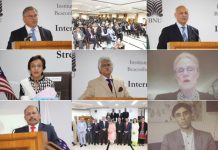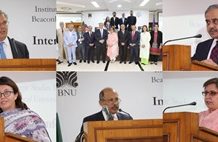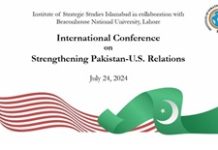Peace is gone. It looks that US ‘regime change policy’ in Afghanistan, Iraq, Libya, Egypt, and Syria has backfired. The policy was counter-productive and faulty, introducing un-ending instability in the region.
The violence of ISIL/ISIS has gone beyond the Middle East. Now the violence has been even threatening door steps of Europe and Americas alike. Republics in Central Asia have been receiving ISIL/ISIS threats.
Additionally, Japan faces a dilemma about its Middle East policy after two Japanese nationals were killed by ISIL in January and Japanese Prime Minister shortened his Middle East tour.
Who was behind the formation of the ISIL/ISIS? What were the objectives? Or the group was the combination of forces defeated by the United States and NATO in Iraq, Afghanistan, Syria, Libya, Egypt, and Yemen etc. Things are not yet clear but brutal inhumane activities are underway.
One can term the ISIL/ISIS as a real multinational Jihadi group. The group is even bigger group than formed during the Afghan war against the Soviet Union in the 1980s.
The US authorities have confirmed the travel of over at least 20,000 Jihadis in war zone. At least 3,400 travelled from Europe to join the ISIL/ISIS, they mentioned. They say Russia, France, and Germany are important places for the recruitment of ISIL/ISIS Jihadis. They have also come from the United States. More than one thousand have come from the South East Asia especially from Indonesia and Malaysia. There are reports that Jihadis from Afghanistan and Pakistan also travelled to war zone in Iraq and Syria.
China has been threatened in a big way by ISIL/ISIS. Unlike China, Pakistan officially denies the existence of ISIL/ISIS in Pakistan but Chinese officials admit the presence of Islamic State operators and sympathizers in China. Recently, the existence of ISIL/ISIS was confirmed by Zhang Chunxian, Secretary of the Communist Party of China at Xinjiang.
Militants carried out a number of disruptive activities all over China. Chinese officials have also confirmed that a number of Uyghurs have joined the Islamic militant group, which controls parts of Iraq and Syria. A Chinese media source mentioned that around 300 Uyghurs have joined ISIL. Global media also made such confirmation of Uyghurs involvement in Iraq and Syria.
Uyghurs have a separatist movement, known as the East Turkmen Islamic Movement (ETIM) in Chinese western autonomous province of Xinjiang. They are an ethnic Turkic-speaking minority in China. They want a separatist State of their own in China. Authorities in China convicted over 700 terrorists, separatists, and related criminals last year.
The ETIM has close links with the Islamic Movement of Uzbekistan (IMU), Taliban, and Al-Qaeda. There is a Uyghur-American Association (UAA) based in Washington, D.C with an objective to promote self-determination of Uyghurs. No such association or group was allowed to form a body or to operate from inside Pakistan.
The spread of militancy in Afghanistan, Pakistan, and Iran in the past three decades has also affected the Chinese Muslims. Many of them became radicals and extremists. Many of them were trained in Pakistan’s tribal areas and inside Afghanistan. These regions were the breeding grounds for renewed Uyghurs violence in China. Al-Qaeda and the Taliban provided a springboard to Uyghurs to operate against Chinese authorities.
Uyghurs have fled to Afghanistan, Kazakhstan, Turkey, Vietnam, Laos, Thailand, and Myanmar, fanning more terrorist activities inside China. Turkey is a home to some Uyghur exiles and a source of irritation between Turkey and China.
Uyghurs have an ethnic legacy attached to northern areas of Pakistan. They used to be traders between Kashgar and northern areas under the British control of the Subcontinent. Some Uyghurs came to Pakistan after the Communist revolution in 1949. Soon after Pakistan’s independence, some expected Pakistan to encourage feelings of sovereignty in Xinjiang as another Muslim State on its northern border, but Pakistan did not pay heed to that idea.
The Pakistan-China trade was originally carried by Uyghurs until more regular trade was evolved between the two countries. Later, Uyghurs used Pakistan as a transit point to pilgrimage to Mecca by the 1980s. Some Uyghur students came to study at Madaris run by Hizb-e-Islami and Taliban in Pakistan and settled down there. They were recruited byAl-Qaeda and the Pakistani government banned Uyghur students.
On the demand of the Chinese Government, many were deported and extradited to China. The Uyghur’s and Pakistanis developed a good people-to-people-contact but Pakistan never fueled the separatist and terrorist tendencies among the Uyghurs. Rather, Pakistan has always taken punitive measures and fully endorsed China’s policy on Uyghurs.
Generally, Uyghurs are moderate Muslims and belong to Sufi traditions of Islam. The involvement of powers cannot be ruled out in fanning Uyghur’s terrorism and separatism. The motive could damage the cause of a rising China and the growing strategic and economic partnership between the two countries especially the building of the gigantic China-Pakistan Economic Corridor, which would bring enormous benefits to Xinjiang Autonomous Region and Pakistan.
Views expressed are of the author and do not necessarily reflect the views of ISS or of the Government of Pakistan.













